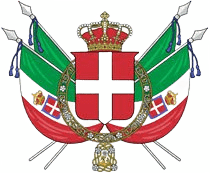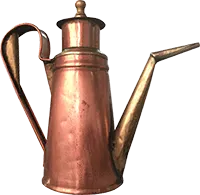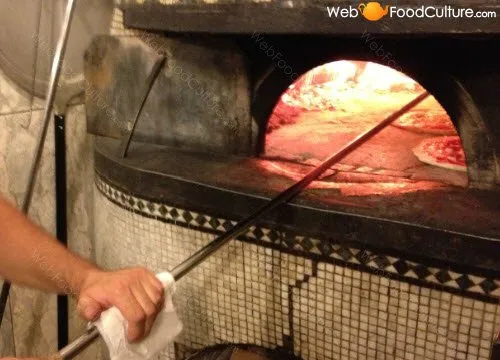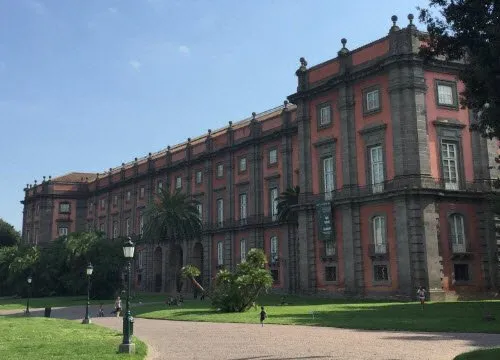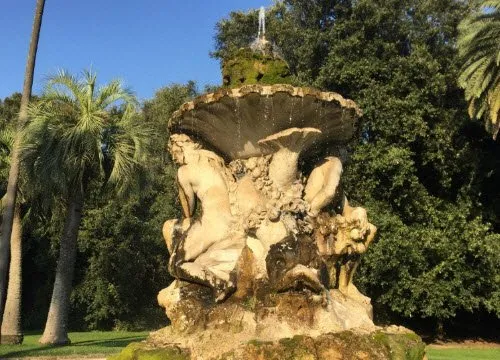Published:
Author: Antonio Maria Guerra
Margherita Pizza
HISTORY, INFO, PLACES, INTERESTING FACTS

Not many know that Margherita Pizza, the ‘queen of pizzas’, takes its name from that of a queen in flesh and blood: Margherita of Savoy. With the precious collaboration of the True Neapolitan Pizza Association, let’s deepen the knowledge of what is probably one of the most famous specialties in the world. Let’s examine its history and how it is made. Let’s find the most traditional pizzeria to taste the original flavor of this delicacy.

The history of Margherita Pizza.
Naples, June 1889: Chef Raffaele Esposito prepares some pizzas for King Umberto I and Queen Margherita of Savoy, on an official visit to the city. Among the different types offered (*1), the regal couple prefers the one topped with tomato, mozzarella, and basil, which, not surprisingly, bears the colors of the Italian flag. When Raffaele is asked the name of such a delicacy, he does not have a moment’s hesitation: his love for the queen and a certain amount of cunning, make him exclaim, “Margherita!”. The most famous of Neapolitan specialties is officially born (*2).
Notes:
*1: The types of pizza offered were three: the ‘Mastiuncola’ (made with lard, grated cheese, olive oil, pepper, and basil), the ‘Marinara’ (made with olive oil, tomato, and garlic) and, precisely, the ‘Margarita’ (made with tomato, mozzarella, and basil).
*2: A document drafted by Camillo Galli, an official of the Royal Household, seems to certify this.

The most traditional pizzerias in Naples.
Here follows a short list of some of the most traditional pizzerias in Naple: places where it’s possible to enjoy the original taste of Margherita Pizza.
Read more
- Pizzeria Brandi
Salita S. Anna di Palazzo 1/2, 80132 Naples (Italy); - Pizzeria Da Michele
Via Cesare Sersale, 1, 80139 Naples (Italy); - Pizzeria Trianon
Via Pietro Colletta, 44/46, 80139 Naples (Italy);


Margherita Pizza STG: the ‘true Neapolitan Pizza’.
In the month of February 2010, the European Union recognized the value of Neapolitan pizza by assigning it the STG (Traditional Specialty Guaranteed) mark of origin. This mark certifies compliance with a procedural guideline defining the characteristics that the original specialty must possess, both in terms of the ingredients used and the method of preparation.
The ‘True Neapolitan pizza’ is:
“A Food preparation consisting of a leavened dough base, topped and baked in a wood-fired oven.”
The document illustrates (among other things):
- The method to make the doughthrough a proper leavening (of which the stages are described);
- The method to ‘give form’(‘formatura’) to the pizza: a procedure used to shape the dough, which must be carried out compulsorily by hand (the use of a rolling pin or other mechanical tools is strictly prohibited);
The procedure used for proper baking: its meticulous description includes even the movements that the pizza maker (the ‘pizzaiolo’) must perform with the aluminum shovel to turn the pizza inside the oven;
The final result is:
“A round-shaped preparation, characterized by a raised edge, the ‘cornicione’, and a diameter of no more than 35 centimeters.”
Naples, the birthplace of Margherita.
Naples is the capital of the Campania Region, located in southern Italy. The city is famous not only for its incredible beauty but also for the richness of its history and culture. It is impossible not to mention its gastronomy, which has given birth to internationally renowned specialties such as, for example, Margherita Pizza.

Brandi: the pizzeria of Margherita Pizza.
There is one pizzeria in Naples that, more than any other, can boast a close relationship with the Margherita: it is Pizzeria Brandi. The restaurant, still in business today, once belonged to Maria Giovanna Brandi, wife of the very Raffaele Esposito who offered the specialty to the Savoy Queen.

The ingredients of Margerita Pizza.
According to the procedural guideline for the ‘True Neapolitan Pizza’ (‘Verace pizza napoletana’), the original Margherita Pizza can be made using only the following ingredients:
Ingredients for the dough:
- Wheat flour;
- Brewer’s yeast;
- Natural water;
- Sea salt or table salt;
Ingredients for the seasoning:
- Peeled tomatoes and/or fresh ‘pomodorini’ (cherry tomatoes);
- Extra virgin olive oil;
- Mozzarella di Bufala Campana DOP;
- Mozzarella STG or Fiordilatte DOP;
- Basil;
Apart from Margherita, the guideline includes only the recipe for another type of pizza: the ‘Marinara’. It’s seasoned just with tomato, garlic, oil and oregano;
La preperazione della pizza Margherita in video.
In questo video viene mostrata la preparazione della pizza Margherita presso la celebre Pizzeria Brandi, il locale che tanto è legato a questa specialità. Si ringrazie l’autore della ripresa BG tourism.


Margherita Pizza: a ‘puzzle’ of taste.
It’s possible to say that the Margherita Pizza represents the final act of a millennia-long evolution, the modern version of a food of very ancient origins. Its long journey begins with a simple flatbread, continues with the addition of mozzarella cheese, and ends with the introduction in the recipe of tomato, the vegetable imported from the New World.
All pieces of a sort of ‘taste puzzle’ that found its completion in Naples, and from there it spread throughout the world, multiplying itself in a huge number of variations.
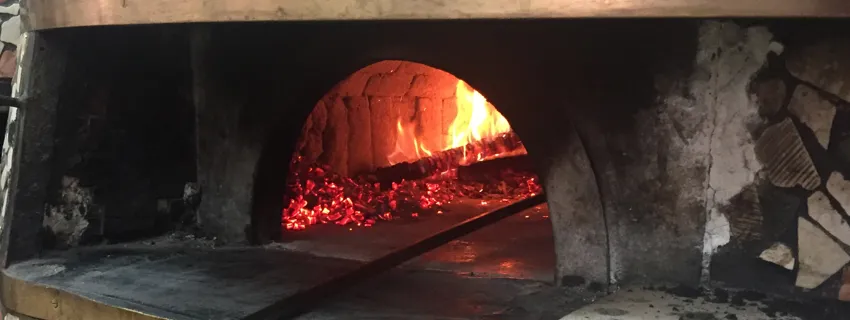
An 'igloo' oven for Margherita Pizza.
The shape of the oven commonly used to bake pizza closely resembles that of an igloo. Its inner part, the ‘vault’ (‘volta’), is entirely covered with refractory material, so as not to disperse heat. The same material is used for the cooking surface (‘piano di cottura’). The fumes produced by the burning of the wood are vented outside through a chimney. The structure has a small arched opening that can be closed with a small metal door when not in use.
A curiosity: in traditional pizzerias, the ovens are almost never turned off.
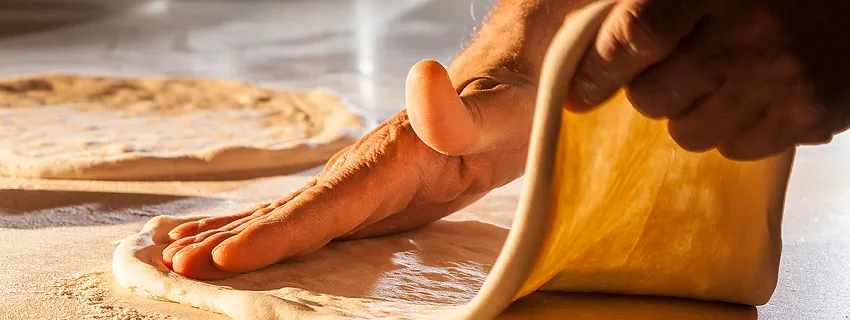



Margherita: calories and nutritional values.
On average, 100 grams of Margherita contain 250 / 270 kcals. Since one pizza usually weighs around three hectograms, the total is about 750 / 810 kcals. The speciality includes carbohydrates, fats (lipids), proteins, mineral salts (calcium), sodium and antioxidants (lycopene);

The most expensive pizza.
In May 2010, a programmer paid for two takeaway pizzas using the newborn electronic currency known as ‘bitcoin’. In recent years, the value of this currency has soared sharply: at the current exchange rate, the amount paid is about 6 million dollars: 3 million for each pizza!

The right beverage for Margherita Pizza.
What is the best beverageti to acompany the Margherita Pizza?
A good choice could be a beer, quite soft, medium warm, quite fresh and medium sparkling.
Read more
- Its softness balances the acid tendency of the tomato;
- Its alcohol balances the greasiness of the olive oil:
- Its acidity and the effervescence balance the sweet tendency of the dough;

The Bourbons loved pizza.
In Naples, long before the arrival of the Savoy family, another great royal family deeply loved pizza: the Bourbons. Suffice it to say that King Ferdinand felt such a passion for the specialty that he ordered the construction of a special oven at the Palace of Capodimonte.
The famous Neapolitan writer Salvatore Di Giacomo, in one of his works, describes a party during which the sovereign’s wife, Queen Maria Carolina of Hapsburg, had the opportunity to taste pizzas baked in this very oven (*1):
“The oven was built in the same forest of Capodimonte. The pizzas were prepared and put in the oven half an hour after midnight. In two or three minutes there she is, with four or five ladies of the court, the queen: other veiled ladies arrive shortly after: Don Domenico counts twenty of them. The Queen eats a two-grand pizza with a good appetite, the ladies imitate her laughing. The servants pour white wine and bring oranges, the dancing in the Palace begins again, and the vision disappears.” (Salvatore Di Giacomo)
Notes:
*1: It’s possible to see the oven still today, when visiting the Royal Palace pf Capodimonte.

AVPN: Associazione Verace Pizza Napoletana
Quest’articolo è frutto della collaborazione tra WebFoodCulture e l’Associazione Verace Pizza Napoletana (AVPN), organizzazione che riunisce alcuni tra i produttori più tradizionali della celebre specialità.
Copyright information.
The images displayed in this page belong to WebFoodCulture and to the Associazione Verace Pizza Napoletana, with the exception of:
Public Domain images
- King Umberto I, 1878 (Wikipedia Link) {PD-Art}
- Margherita of Savoy, Queen of Italiy, 1870 (Wikipedia Link) {PD-Art}
- Portrait of Ferdinando I, King of the Two Siciles, V.Camuccini, 1818 (Wikipedia Link) {PD-Art}
Immagini Creative Commons
- Great Royal Coat of Arms of the Two Sicilies (Wikipedia Link) {PD-Art}

